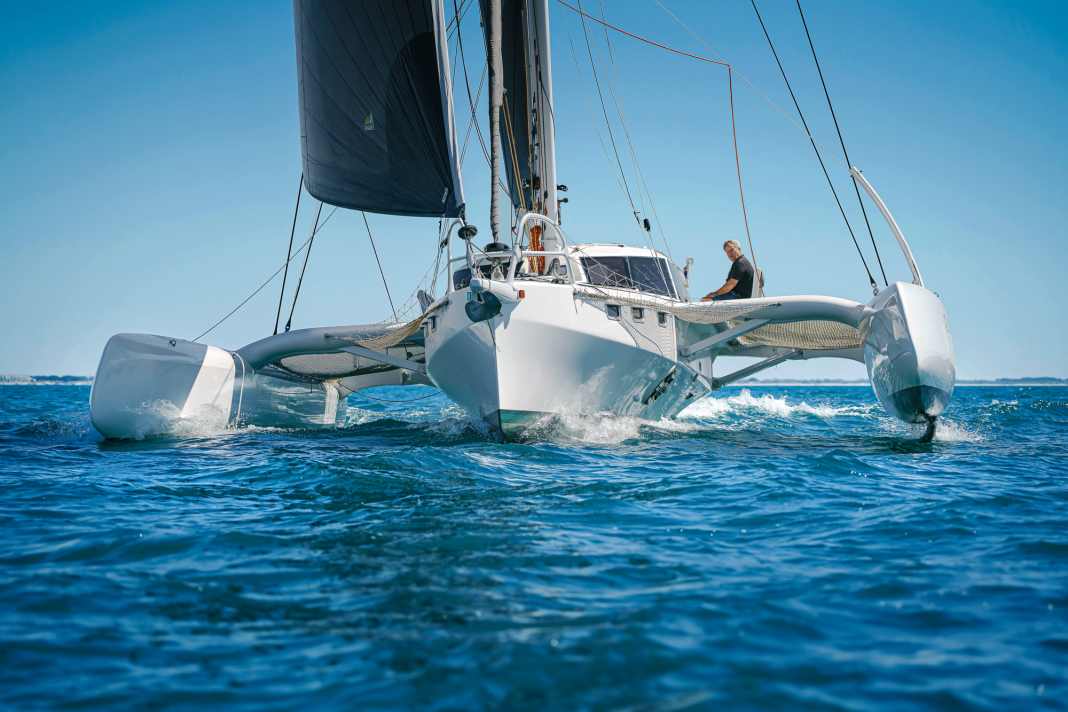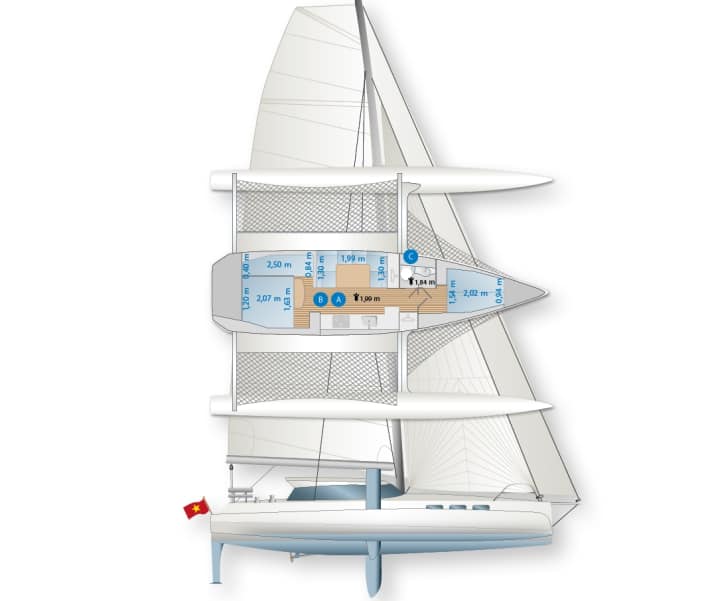





More than 2,000 nautical miles across the Mediterranean, mostly against the wind and sometimes in stormy winds and high waves: Paul Koch, boss and owner of the Rapido Trimarans brand in Vietnam, took it upon himself to ferry the Rapido 40 model number two from Greece to the south of France for the multihull trade fair in La Grande-Motte. A tough trip for the skipper and also a stress test for the boat, a trial by example. "I simply wanted to see what my boat was capable of on the long route and where there was still potential for improvement," says Koch after the extremely demanding, but apparently also completely problem-free crossing.
The trimaran line extended downwards
The Rapido 40 is now the third and smallest trimaran from the brand, which has been building tri-hull boats in the Vietnamese business metropolis of Ho Chi Minh City since 2014. Five of each of the larger Rapido 50 and 60 models have been produced and sold to date. The new, smaller 40 model now appears to be in greater demand and therefore also in higher numbers. Six boats have already been delivered and 14 more are still on the order books. A great success for Rapido Trimarans, after all a purely niche product quite far removed from the mass market. The competition is also more than manageable. The only comparable competitor to the Rapido 40 in terms of size is currently the Dragonfly 40 from Quorning Boats in Denmark.
Its enormous width is a not insignificant disadvantage for sporty trimarans of this type, especially when manoeuvring and mooring in the harbour. With a hull length of around twelve metres, the Rapido 40 has an impressive span of 8.80 metres. The Dragonfly 40 is 8.40 metres. In contrast, boats of similar length from the Lagoon or Fountaine Pajot range of twin-hull boats are around two metres narrower.
The trimaran can become narrower
The width of both the Rapido and the Dragonfly can be reduced mechanically. On the boat from Vietnam, the beams are folded in using hinges and the floats are pulled towards the main hull. However, quite extensive preparations are necessary for this process: numerous screw connections and the trampolines have to be loosened and the entire rig relieved. The system is therefore too complex for regular folding of the hulls, for example when approaching a harbour. However, the shipyard is already working on more user-friendly alternatives.
The whole thing is much simpler with the Dragonfly. The hulls can be swivelled sideways to the rear of the centre fuselage.
All three hulls of the Rapido and the deck of the main hull are made of carbon fibre, as a sandwich construction with a foam core and vinyl ester resin. The heavily loaded beams are also made entirely of carbon fibre, with a monolithic core. The same applies to the bulkheads and the structurally load-bearing parts of the interior fittings, such as the furniture foundations. The Vietnamese also manufacture the profiled wing mast themselves from carbon fibre in the shipyard, even using carbon prepregs and curing in an autoclave.
With a total weight of just 5.2 tonnes, the Rapido 40 is correspondingly light. By way of comparison, cruising catamarans of the same length displace about twice as much with an unladen weight of around ten tonnes.
The trimaran has plenty of speed potential
The consistent lightweight construction, the noticeably stiff carbon fibre connections and the potent sail plan with the rotating wing mast naturally result in an unusually high performance potential. What's more: The side hulls are fitted with asymmetrical, curved foils that prevent drift and generate additional lift. During the test in the south of France in constant conditions of around twelve knots of wind, the Rapido 40 with the standard sail plan (full battened main with squarehaed and self-tacking jib) logged a remarkable eight knots or more upwind. Significant here is the excellent height on the wind. The Tri tacks at an angle of only 85 degrees in medium wind speeds - an astonishingly good value for multihulls!



It really gets down to business with the Code Zero furled. At half wind, the trimaran's log quickly reaches double figures. From this speed upwards, the foils and their buoyant force become noticeably effective. Incidentally, the angle of attack of the wings can be trimmed using adjustable guides.
The trimaran is steered with a tiller
Depending on the weather and wind, the helmsman can either sit sideways in an airy and elevated position on the very comfortable benches. Or he can take up a more secure position on the side deck, where he is better protected. There is no alternative to the tiller steering system with telescopic boom; Rapido does not offer one or even two steering wheels as an option for the trimaran, as is the case with the Dragonfly.
On long journeys, the autopilot, which is attached directly to the rudder shaft, takes over anyway. The boat can also be easily steered from the inside using the remote control. The striking cabin superstructure with the almost all-round window strip and the large roof hatches allows an almost unrestricted all-round view when sailing as well as upwards into the cloths.
The trimaran is also a lightweight construction on the inside
The seating area in the saloon is raised, as on a classic yacht with a deck saloon. This is very comfortable not only in the harbour and in the bay, but also on long trips at sea. Rapido Trimarans has consistently opted for lightweight construction for the interior below deck: covers, doors and furniture parts are made of composite, and even the drawers are made of carbon fibre.
Wood is generally in short supply, and very light but non-slip and non-slip cork was chosen for the flooring in the saloon. As a result, the standard fittings below deck give a more sober than cosy impression. The workmanship is generally good, even if the details are not completely flawless. The wiring of the electrical and electronic components is rather unattractive and confusing. On the other hand, there is praise for the perfect ventilation options with cross ventilation in all living areas.
Four people can find a berth on the trimaran
Two people sleep comfortably in the foredeck. The width of the double berth is 1.54 metres at shoulder height. There are numerous large storage spaces in the owner's area. There is also plenty of space in the toilet room. However, there is no partition for the shower area, but this could easily be retrofitted. Another two people can sleep quite comfortably aft, but access to the cabin is quite narrow: You have to make yourself small and then crawl to the bunk. The aft cabin can be reached more comfortably via a hatch in the aft bridge deck directly from the cockpit.
The Rapido 40 costs just under 760,000 euros in the standard version ex shipyard. In addition, the customer has to factor in at least 30,000 euros for a good set of sails. At first glance, the rather sobering asking price is put into perspective by the unusually extensive and, above all, very exquisite basic equipment. This includes the profiled wing mast and the foils. In addition, the high-quality construction with a large proportion of carbon fibre at least partially justifies the high asking price.

Technical data
- CE design category A
- Hull length 12.03 m
- Waterline length 12.00 m
- Width 8.80 m
- Width reduced 5.80 m
- Draught 0.87-2.18 m
- Mast height above WL 19.25 m
- Theoretical hull speed 8.4 knots
- Weight 5.2 tonnes
- Mainsail 65.0 m²
- Self-tacking jib 32.0 m²
- Reacher 113.0 m²
- Engine (Yanmar) 21 kW/29 hp
- Fuel tank (PVC) 200 litres
- Fresh water tank (PVC) 200 litres
- Holding tank (PVC) 60 litres
Hull and deck construction
Carbon fibre sandwich with foam core and vinyl ester resin, built up with vacuum infusion. Beams, foils, rudder blades and main bulkhead built partly with carbon fibre prepreg and cured in an autoclave
Optional hybrid drive
Alternative to the built-in diesel: two electric motors from Oceanvolt, each with an output of 8 kW, two lithium batteries and a generator with an output of 6 kW. Surcharge for the entire system: around 105,000 euros
Sailing
The type, quality and manufacturer are determined by the customer. The sails are not included in the basic price. A set of cruising sails (main and jib) costs 27,520 euros
Equipment and prices
- Base price ex shipyard € 759,520
- Price ready to sail € 809,565
- Comfort price € 833,080
As of 9/2023, how the prices shown are defined can be found here !
Guarantee/against osmosis
- 2/10 years
Shipyard and distribution
Rapido Trimarans, Triac Composites; Ho Chi Minh City (Vietnam), www.rapidotrimarans.com
Multihull-Vertrieb, Werner Stolz; Wettersteinstr. 16, 82024 Taufkirchen, www.multihull-sale.de
YACHT rating
Exciting alternative on three hulls. Plenty of power combined with good sailing characteristics allow for speedy progress on all courses. But comparatively high price
Design and concept
- + Consistent lightweight construction
- + Variable draught
- - Cumbersome width reduction
Sailing performance and trim
- + Enormous speed potential
- + Runs very well upwind
- + Various tax items
Living and finishing quality
- + All-round view in the saloon
- + Spacious forward cabin
- - Saloon table is very wobbly
Equipment and technology
- + Carbon wing mast is standard
- + electric motor possible
- + High-quality basic equipment

